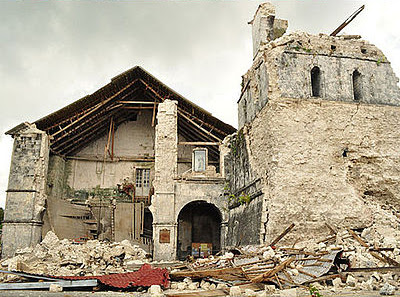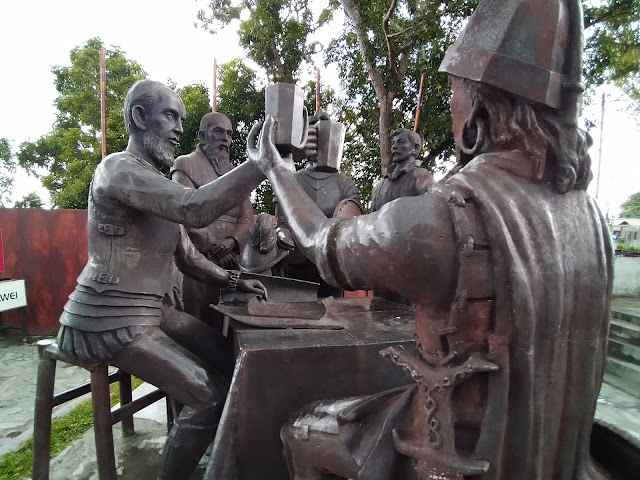Countryside Sweep: Baclayon Church, Blood Compact Monument, Xzootic Park
Bohol Countryside Tour Part 3
Life will always have its ups and downs. The past few years had been difficult for most of us with all the restrictions and the dangers of the disease. Thankfully, the challenges did not last long and little by little we are starting to gain the freedom that was taken from us by the pandemic.
The island and people of Bohol is by no means a stranger to these downs. It had to endure a devastating earthquake and multiple typhoons, in addition to the pandemic. Nevertheless, the people will always pick themselves up and life will continue to go on.
Once we finished our lunch in the beautiful Loboc River, we still had a few spots to check off the countryside tour list. Rain was forecasted for the day and we don't know how long the sky will hold up.
The Province and Towns of Bohol
Bohol is a relatively large province, being the 23rd largest among 82 provinces. Thus there is a lot to unpack in this island that our excursion would barely scratch its hilly surface. Tagbilaran, the capital and only city, serves as a gateway to most of the tourist destinations in the province.
The town of Carmen at the center of the island is the home of Chocolate Hills. Loboc boasts of the river that passes through it and is also the home of the world-renowned Loboc Children's Choir. Being one of the first islands the Spaniards landed into, century-old churches therefore dotted the province, famous among them being the one in Baclayon.
Mountain ranges run through the south of the island, the highest among them being Mt. Matunog in the town of Jagna. While the beaches of Panglao Island are the most visited by tourists, the town of Anda should also not be overlooked as it also hosts a nice beach as well as numerous cave pools. The town of Talibon on the north of the island is the birthplace of the eighth president of the Philippines, Carlos P. Garcia.
The seemingly peaceful island is not bereft of tragedies. On the morning of October 15, 2013, a magnitude 7.2 earthquake rocked the province that lead to the death of around 200 Boholanos and massively damaged structures around the island. On December 2021, typhoon Odette (Rai) hit the island which left more than a hundred people dead and flooded several areas near rivers.
But the locals are nothing if not resilient. Today, Bohol is open to visitors and we are glad to have had the opportunity to experience tropical bliss in these islands.
Getting Around Bohol
We conducted our countryside tour via private car but it would not be difficult to catch a tricab operator or two that will offer to take you on a day tour of the island. Jeepneys, buses, and UV Express also ply the roads of Bohol at regular schedules most of which starts and ends at Dao Terminal in Tagbilaran City.
Xzootic Animal Park and Butterfly Garden
After a fifteen-minute drive from Loboc Tourism Complex, we stopped over at the nearby town of Loay to see the animals at Xzootic Animal Park. The park charges an entrance fee of Php 100 per person.
 |
| Entrance to Xzootic Animal Park |
Upon entrance, we were immediately greeted by the taxidermied remains of a large python.
The park is small and only houses a few animals, some of which can be interacted with. Among them are the Burmese pythons, which are definitely alive and are docile (or full?) enough allowing us to touch them.
The other animals are not as free as the pythons though and are mostly behind cages. Some animals looks like they are in dismal condition. The staff mentions that the park also felt the brunt of typhoon Odette as Loboc River overflowed and drowned some of the animals including a crocodile.
 |
| Eclectus parrot |
 |
| A lone crocodile |
 |
| Civet cat |
Adjacent to the animal park is the butterfly garden, where several shrubs serve as nesting grounds for butterflies. Some of the butterflies were even allowed to perch on our arms. The buggy sensation of their legs are undeniable. Sadly, the park staff mentions that the recent rains contribute to the much shorter lifespan of the butterflies.
 |
| Interior of the Butterfly Garden |
Outside the garden, there is a small gallery of butterfly specimens as well as a display of the several stages of butterfly pupa from different species.
Again, the park is small so everything can be seen in a quick visit and it did not take us long before we are on the road again to visit the next destination.
Baclayon Church
At close to 2:00 pm, the sun again peeked out as we got out of the car to see the Church of the Immaculate Conception in the town of Baclayon. Baclayon Church, as it is more commonly known, is a stone church first constructed under Jesuit purview in 1727. The church, which faces the sea, is cross shaped (as is common among the churches of Bohol) and is originally built out of coral stones.
 |
| Detail of the bell tower and side entrance |
In 1994, the church has been declared a National Historical Landmark and in 2010 a National Cultural Treasure. Unfortunately, the 2013 earthquake massively damaged the church and today the facade and bell tower is a reconstruction after the original ones are destroyed.
 |
| Earthquake damage to Baclayon Church © Wikimedia Commons User:Joelaldor / CC-BY-SA-4.0 |
The church was closed on the day of our visit although the nearby museum is open for visitors to see the relics from the old church. For our part, we contented ourselves with viewing the exterior of the church.
 |
| The museum is adjacent to the church |
At the time, I have just finished the book Pillars of the Earth by Ken Follett which details the construction of an English cathedral. While not a cathedral, I was still fascinated about the technique people would have used in constructing Baclayon Church using 16th century technology.
A handful of tourists were also gathering and one of them offered to take our picture, but not before mistaking us for Japanese tourists.
 |
| 教会の前に |
Blood Compact Monument
With not much else to do, we headed back to Kuya Jason's car. Our last destination for the day is the Blood Compact monument in Tagbilaran City.
The monument depicts the 1565 sanduguan or blood compact between the Spanish explorer Miguel Lopez de Legazpi and the chieftain of Bohol, Rajah Sikatuna aboard the ship San Pedro to seal a peace treaty between the two peoples. Legazpi would afterwards commence the 300 years of Spanish rule in the Philippines.
 |
| Blood Compact Monument at Tagbilaran City |
The monument is a life-sized bronze sculpture by the National Artist and Boholano Napoleon Abueva. Even if telling an important story of the people of Bohol, we cannot help but be reminded of the typical tourist trap, as vendors were gathered beside the shrine peddling souvenir items. But then again, locations such as these give them a livelihood opportunity.
 |
| Details of the sculpture |
Wrapping Up
At about 2:30 in the afternoon, we finally left Legazpi and Sikatuna with their business. We still have a lot of time left in the day, but our bodies were already aching for a good nap. And as timing would have it, the rain finally fell just as we were driving by the roads of Panglao Island sitting (and dozing off) comfortably at the back of the white sedan.
At quarter to three, we finally got back at our accommodation where we had a long nap after a long day on the road visiting to and learning about the treasures of Bohol.
Up Next
So ended our first day on Bohol. In contrast with the comfort of our commute visiting spots to and fro, the next day will be a challenge as we would go and summit Bohol's highest point, Mt. Matunog.






Comments
Post a Comment